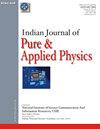Unsteady MHD CNTs-blood Nanofluid Flow and Heat Transfer under the Effects of Viscous Dissipation, Resistive heating, and Thermal Radiation over a Sensor Surface Accompanied by Variable Viscosity
IF 1.1
4区 物理与天体物理
Q4 PHYSICS, MULTIDISCIPLINARY
引用次数: 0
Abstract
The numerical scrutiny of unsteady incompressible magneto-hydrodynamics (MHD) for blood flow in carbon nano tubes (CNTs), past a sensor surface has been presented under the influences of viscous dissipation, resistive heating, and thermal radiation. The variables without having dimensions have been deployed to alter the reigning flow equations, which are non-linear, coupled partial differential equations (PDEs), into the system of non-linear coupled ordinary differential equations (ODEs). The bvp4c tool of MATLAB software has been exercised to obtain the numerical solutions of the dimensionless governing system. The graphs and tables have been formed for the SWCNT-blood and MWCNT-blood nano-liquids for the velocity and temperature profiles versus the unsteadiness parameter, magnetic parameter, magnetic field inclination angle, radiation parameter, and Eckert number. It has been observed that the velocity profile of MWCNT-blood nanofluid is higher than the velocity profile of SWCNT-blood nanofluid except for radiation parameter and Eckert number. However, a reverse trend has been noted for temperature profiles for both nanofluids for all other governing parameters. The comparison tables, for the values of the local skin friction factor and the local Nusselt number, for the various governing parameters, match with outcomes of the previously reported data and validate the employed technique for the solution.非定常MHD碳纳米管-血液纳米流体在粘性耗散、电阻加热和热辐射影响下的流动和传热
在粘性耗散、电阻加热和热辐射的影响下,研究了非定常不可压缩磁流体力学(MHD)对碳纳米管(CNTs)血液流过传感器表面的影响。利用无量纲变量将非线性耦合偏微分方程的控制流方程转化为非线性耦合常微分方程。运用MATLAB软件中的bvp4c工具,得到了该无量纲控制系统的数值解。我们绘制了swcnts -blood和mwcnts -blood纳米液体的速度和温度与非稳态参数、磁性参数、磁场倾角、辐射参数和Eckert数的关系曲线和表格。观察到除了辐射参数和Eckert数外,mwcnts -血纳米流体的速度分布高于swcnts -血纳米流体的速度分布。然而,在所有其他控制参数下,两种纳米流体的温度分布都出现了相反的趋势。对于各种控制参数的局部皮肤摩擦系数和局部努塞尔数的值的比较表与先前报告的数据结果相匹配,并验证了所采用的解决方案的技术。
本文章由计算机程序翻译,如有差异,请以英文原文为准。
求助全文
约1分钟内获得全文
求助全文
来源期刊
CiteScore
1.30
自引率
14.30%
发文量
42
审稿时长
7 months
期刊介绍:
Started in 1963, this journal publishes Original Research Contribution as full papers, notes and reviews on classical and quantum physics, relativity and gravitation; statistical physics and thermodynamics; specific instrumentation and techniques of general use in physics, elementary particles and fields, nuclear physics, atomic and molecular physics, fundamental area of phenomenology, optics, acoustics and fluid dynamics, plasmas and electric discharges, condensed matter-structural, mechanical and thermal properties, electronic, structure, electrical, magnetic and optical properties, cross-disciplinary physics and related areas of science and technology, geophysics, astrophysics and astronomy. It also includes latest findings in the subject under News Scan.

 求助内容:
求助内容: 应助结果提醒方式:
应助结果提醒方式:


